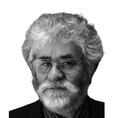In 1966, American mathematician Steve Smale was awarded a Fields Medal, a kind of Nobel Prize for mathematics.
At a press conference at the International Congress of Mathematicians in Moscow, Smale attacked both US and Russian foreign policy and the military aggression of the two superpowers. Smale came under intense criticism from the Johnson administration for his opposition to the Vietnam War.
Copacabana connection
As a postdoctoral fellow in Rio de Janeiro in 1960, Smale worked on mathematical problems that were to prove of central importance in the emerging field of chaos theory. He had an office at the newly established Institute for Pure and Applied Mathematics (IMPA) in Rio.
READ MORE
Smale spent his mornings on the beautiful beach of Copacabana and his afternoons at IMPA. It sounds surprising, but thinking up new ideas, testing novel approaches, modifying assumptions, verifying hypotheses, trying special cases and checking and recording everything is mentally very demanding.
Smale’s beach-time research was remarkably productive: the headline of this article comes from a review he wrote in 1998.
After his Brazilian sojourn, Smale took up a professorship at Berkeley. In 1965, President Johnson escalated the Vietnam War, and Smale led some student demonstrations against US military aggression.
Politicians took a dim view of his al fresco research: Johnson’s science adviser questioned why taxpayers should support research on the beaches of Rio. Political factors influenced the rejection of Smale’s next funding application to the National Science Foundation.
[ Maryam Mirzakhani: Only woman to win a Fields medalOpens in new window ]
Recently, a 1960 letter from MIT professor Norman Levinson to Smale was found in an archive at IMPA. It concerned research originating with a second World War study of radar by Mary Cartwright and John Littlewood and revealed an error invalidating Smale’s work. But blunders can be a boon: in correcting the error, Smale was led to a discovery, the horseshoe map, that would foreshadow a scientific revolution.
To describe the horseshoe map, think of how a baker stretches and folds dough to mix it well. Repeating this action, nuts and raisins originally clustered in one place will be spread out uniformly in the loaf. Smale showed that the horseshoe map can be represented by a sequence of tosses of a coin, the paradigm of pure chance. His discovery had consequences that might be described as chaotic.
Emergence of chaos
The recognition of “sensitive dependence to initial conditions” is now an essential starting-point for solving many problems in science. Newton’s laws of motion provided a means to predict the motion of mechanical systems. Scientists came to believe that, given precise initial conditions, the behaviour of a physical system up to any future time could be predicted accurately.
In the 1970s, a revolutionary new scientific perspective, chaos theory, emerged, and it dealt a severe blow to Newtonian determinism. Chaos became evident through the deep analysis of the equations underlying Newtonian mechanics. Through mathematics, the inadequacy of Newtonian determinism was revealed.
Chaos was already implicit in the work of Cartwright and Littlewood and, much earlier, in Henri Poincaré’s studies in celestial mechanics, but the world was not ready to accept the counterintuitive ideas it entailed.
A few months after the discovery of the horseshoe map, Smale made a breakthrough in topology. He proved a key conjecture of Poincaré in dimensions greater than 4. It was for this that he was awarded the Fields Medal in 1966.
Peter Lynch is emeritus professor at UCD School of Mathematics & Statistics. He is giving a course on recreational mathematics, AweSums: the Majesty and Magnificence of Mathematics, this autumn in UCD – registration is now open. He blogs at thatsmaths.com












